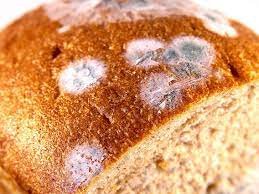Mold growing on the bread can be microscopic fungi belonging to different species like Penicillium, Rhizopus, Aspergillus, Monascus and Fusarium. They are of different shapes and colors depending on the species. Rhizopus stolonifer is the most common and fast growing bread mold. It is also known as black mold as it appears dark green or black in colo
They’re what gives mold its color — white, yellow, green, gray, or black, depending on the type of fungus. Mold is a fungus in the same family as mushrooms. Fungi survive by breaking down and absorbing the nutrients of the material on which they grow, such as bread.
The fuzzy parts of mold you see on bread are colonies of spores — which is how the fungus reproduces. Spores can travel through the air inside the package and grow on other parts of the bread.
Penicillin is the first antibiotic medication made from the fungus Penicillium chrysogenum and the credit for this discovery goes to Alexander Fleming, the great scientist.
DON’T EAT THE MOLD ON BREAD
Some mold is safe to consume, such as the types purposely used to make blue cheese. However, the fungi that can grow on bread give it an off-flavor and may be harmful to your health.

It’s impossible to know what kind of mold is growing on your bread just by looking at it, so it’s best to assume it’s harmful and not eat it.
Additionally, avoid smelling moldy bread, as you may inhale spores from the fungus. If you have an allergy to mold, inhaling it could lead to breathing problems, including asthma.Those with allergies to inhaled mold may also experience harmful reactions — including life-threatening anaphylaxis — if eating it in food. Still, this appears to be uncommon. In addition,people with weak immune systems — such as from poorly controlled diabetes — are vulnerable to infection from inhaling Rhizopus on bread. Though uncommon, this infection is potentially life-threatening.
CAN WE SALVAGE MOLDY BREAD
The Food Safety and Inspection Service of the United States Department of Agriculture (USDA) advises discarding the entire loaf of bread if it has developed mold.Some mold can produce harmful and invisible poisons called mycotoxins. These may spread through bread, particularly when mold growth is heavy.Though you may only see a few spots of the fungus, its microscopic roots can spread quickly through porous bread. Therefore, don’t try to scrape off mold or salvage the rest of your loaf.
CAN WE FEED OUR PETS WITH MOLDY BREAD
High intake of mycotoxins may cause digestive upset or other illness. These toxins can also sicken animals, so don’t feed contaminated bread to your pets.
Furthermore, mycotoxins may negatively affect their intestinal health, possibly by altering the makeup of the microbes that inhabit their gut.
PREVENTION
Moisture contributes to the faster growth of mold. Hence, do not allow your bread to turn moist. It is always better to preserve the bread that is brought from the store, in its original packaging bag.
.jpeg)
Source
If you are making bread at home, use ingredients that contain oils, like butter, eggs, milk, etc. This will allow the bread to stay fresh for longer period.
Breadbasket is another option for storing bread for a long time. A variety of breadbaskets made of wood, clay and metal are best for bread storage as they can keep your bread dry and moisture free.
Make it a point to consume bread or other similar foods as fresh as possible. If you find mold growth appearing on the food, do not attempt to eat it all or in parts and dispose it off immediately.
Bread molds can be infectious and hence you should avoid touching it with bare hands. Also, molds release organic compounds like benzene and acetone that are responsible for causing headaches, dizziness and nausea. It is not necessary to be allergic to molds, anyone can react to them very easily.
SIDE EFFECTS OF EATING MOLDY BREAD
1.Vomiting and nausea
If you see moldy bread, the first thing you should do is discard it! The mold means that the bread is filled with bacteria. If you eat moldy bread by mistake, it doesn't mean you have to rush to the hospital for this. You can even digest it easily if you have a healthy immune system. While it might not be fatal to you it still can cause nausea and vomiting.
2.Allergic reaction
You can’t tell what type of mold has infected your bread, which is why there is no use in trying to salvage the moldy bread. Many people are allergic to fungus, they can have a serious issue if they eat a slice of moldy bread. It is not common but it can lead to fatal allergic reactions. People with weak immunity are prone to catching infection from just smelling the fungus again this is not very common but why take that risk!
3.Mycotoxins
The probability of this happening is very less but if you make it a habit of scraping out the infected portion of bread and consuming it then there will be some long term health problems. Some molds produce toxic substances called mycotoxins. These mycotoxin strains can cause cancer, so just go and buy a new loaf of bread instead of salvaging them.
.jpeg)
Source
4.Respiratory issues
Eating moldy bread also causes respiratory problems. One can develop irritations in the nose, mouth and throat which will take some time and medicines to heal them.